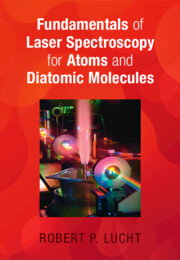Book contents
- Frontmatter
- Dedication
- Contents
- Preface
- 1 Introduction
- 2 Atomic Structure and the Quantum Mechanics of Angular Momentum
- 3 Structure of Diatomic Molecules
- 4 Quantum Mechanical Analysis of the Interaction of Laser Radiation with Electric Dipole Resonances
- 5 Quantum Mechanical Analysis of Single-Photon Electric Dipole Resonances for Diatomic Molecules
- 6 Absorption and Emission Spectroscopy
- 7 Raman Spectroscopy
- 8 Coherent Anti-Stokes Raman Scattering (CARS) Spectroscopy
- Spherical Harmonics and Radial Wavefunctions for One-Electron Atoms
- Clebsch–Gordan Coefficients, Dipole Moments, and Spontaneous Emission Coefficients for the 2p–1s Transition in Atomic Hydrogen
- Properties and Values for Selected 3j Symbols
- Properties and Values for Selected 6j Symbols (Weissbluth, 1978)
- Allowed LS Coupling Terms for Equivalent d2 Electrons
- Derivation of the Higher-Order Density Matrix Elements for Doublet and Triplet Electronic Levels
- Einstein Coefficients for Spontaneous Emission for the X2Π–A2Σ+ (0,0) Bands of OH and NO and the X3Σ−–A3Π (0,0) Band of NH
- Effect of Hyperfine Splitting on Radiative Transition Rates
- Voigt Function Values
- References
- Index
8 - Coherent Anti-Stokes Raman Scattering (CARS) Spectroscopy
Published online by Cambridge University Press: 12 December 2024
- Frontmatter
- Dedication
- Contents
- Preface
- 1 Introduction
- 2 Atomic Structure and the Quantum Mechanics of Angular Momentum
- 3 Structure of Diatomic Molecules
- 4 Quantum Mechanical Analysis of the Interaction of Laser Radiation with Electric Dipole Resonances
- 5 Quantum Mechanical Analysis of Single-Photon Electric Dipole Resonances for Diatomic Molecules
- 6 Absorption and Emission Spectroscopy
- 7 Raman Spectroscopy
- 8 Coherent Anti-Stokes Raman Scattering (CARS) Spectroscopy
- Spherical Harmonics and Radial Wavefunctions for One-Electron Atoms
- Clebsch–Gordan Coefficients, Dipole Moments, and Spontaneous Emission Coefficients for the 2p–1s Transition in Atomic Hydrogen
- Properties and Values for Selected 3j Symbols
- Properties and Values for Selected 6j Symbols (Weissbluth, 1978)
- Allowed LS Coupling Terms for Equivalent d2 Electrons
- Derivation of the Higher-Order Density Matrix Elements for Doublet and Triplet Electronic Levels
- Einstein Coefficients for Spontaneous Emission for the X2Π–A2Σ+ (0,0) Bands of OH and NO and the X3Σ−–A3Π (0,0) Band of NH
- Effect of Hyperfine Splitting on Radiative Transition Rates
- Voigt Function Values
- References
- Index
Summary
Coherent anti-Stokes Raman scattering (CARS) spectroscopy is a technique that has been widely applied for temperature measurements in combustion and for microscopic imaging of cell structures. CARS spectroscopy is discussed in detail in this chapter as an example of a nonlinear optical technique. The concept of the nonlinear susceptibility is introduced, and the derivation of the susceptibility tensor appropriate for CARS spectroscopy is described in detail. A key aspect of this derivation is the incorporation of the electric dipole transition matrix elements for the Raman scattering process into the susceptibility tensor. CARS spectral modeling and collisional narrowing of CARS spectral features are discussed in detail. The emerging field of femtosecond CARS is discussed. The chapter concludes with detailed examples of CARS intensity calculations.
Keywords
- Type
- Chapter
- Information
- Publisher: Cambridge University PressPrint publication year: 2024

